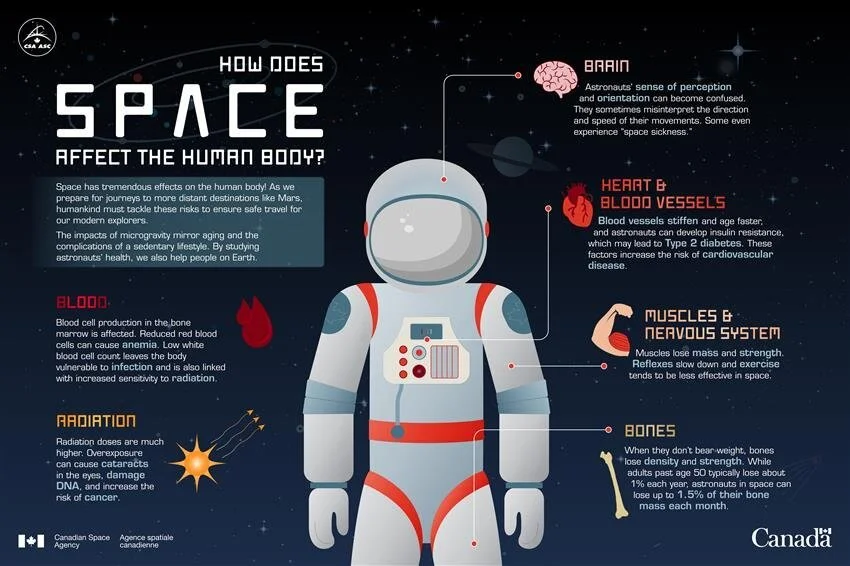Distance Learning Module: The Challenges of Space Travel
As NASA and others talk about more, longer trips to the Moon and plans for a mission to Mars, we have to consider the hostile environments we’ll encounter and the limits on our equipment. What qualities and technological capabilities will astronauts need in order to make those journeys?
We choose to go to the moon in this decade and do the other things, not because they are easy, but because they are hard, because that goal will serve to organize and measure the best of our energies and skills, because that challenge is one that we are willing to accept, one we are unwilling to postpone, and one which we intend to win.”― John F. Kennedy
Consider that...
The space station sits just within Earth’s protective magnetic field, so while our astronauts are exposed to ten-times higher radiation than on Earth, it’s still a smaller dose than what deep space has in store.
Mars is, on average, 140 million miles from Earth. Rather than a three-day lunar trip, astronauts headed to Mars would be leaving our planet for roughly three years.
The atmosphere of Mars is 95.32% carbon dioxide 2.6% nitrogen, 1.9% argon, and trace levels of water vapor, oxygen, carbon monoxide, hydrogen and other noble gases. Earth's is 78% nitrogen, 21% oxygen, and 1% argon.
It takes about 20 minutes for radio signals to move between Mars and Earth—so there's no communicating in real-time, even in an emergency
Americans on the shuttle program were allowed to take 20 personal items with them, weighing no more than 1.5 pounds!
What are some of the challenges that
long-term space travel represents for ASTRONAUTS?
SOME OF THE ISSUES THAT NASA AND OTHER SPACE AGENCIES CONSIDER ARE:
Psychological strain: loneliness, isolation, close quarters, lack of personal space
Access to water, healthy food, and breathable air
Ability to grow food
Health impact of living in zero-gravity
Health impact of exposure to solar radiation
Sleep loss & disruption of circadian rhythms
It's scary! Lots of unknowns
What are some of the challenges that
long-term space travel represents for TECHNOLOGY?
SOME OF THE ISSUES THAT SPACE AGENCIES CONSIDER ARE:
Weight limits (how much fuel/water/food/equipment can we realistically carry?)
Communication limits
Making spacecraft habitable for humans (gravity, radiation, etc.)
Longer missions = more people required & people with more skills (doctors, biologists, geologists, engineers, who else? / trained in computer science, navigation, communications, what else?)
Need equipment that can withstand the demands of operating in harsh conditions (radiation, weather on other planets, what else?)
Watch this video from NASA about water filtration on the ISS:
NASA's Human Research Program
Developed as a result of NASA's refocus of the space program on exploration in 2004, the Human Research Program uses research findings to develop procedures to lessen the effects of the space environment on the health and performance of humans working in that setting. The HRP includes many facets of human space travel such as:
Environmental Factors
Exercise Physiology
Habitability
Human Factors
Medical Capabilities
Physiology
Psychosocial and Behavioral Health
Space Radiation
The Human Research Program divides its areas of study into five Elements: the International Space Station Medical Projects, Space Radiation, Human Health Countermeasures, Exploration Medical Capability, and Human Factors and Behavioral Performance.
Above: NASA astronaut Nicholas Patrick participates in a construction and maintenance spacewalk on the International Space Station, February 2010. Image Credit: https://www.nasa.gov/hrp
Activity: Pick one challenge to long-term space travel, either for humans or technology. In 20 minutes, brainstorm as many possible solutions as you can. Share your ideas with your family or classmates.
"Space is hard – but worth it. We will persevere and move forward together."
―Richard Branson, founder of private spaceflight company Virgin Galactic





